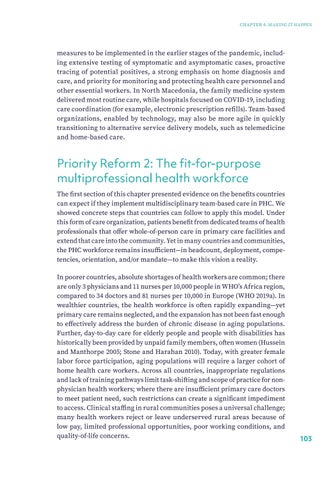CHAPTER 4: MAKING IT HAPPEN
measures to be implemented in the earlier stages of the pandemic, including extensive testing of symptomatic and asymptomatic cases, proactive tracing of potential positives, a strong emphasis on home diagnosis and care, and priority for monitoring and protecting health care personnel and other essential workers. In North Macedonia, the family medicine system delivered most routine care, while hospitals focused on COVID-19, including care coordination (for example, electronic prescription refills). Team-based organizations, enabled by technology, may also be more agile in quickly transitioning to alternative service delivery models, such as telemedicine and home-based care.
Priority Reform 2: The fit-for-purpose multiprofessional health workforce The first section of this chapter presented evidence on the benefits countries can expect if they implement multidisciplinary team-based care in PHC. We showed concrete steps that countries can follow to apply this model. Under this form of care organization, patients benefit from dedicated teams of health professionals that offer whole-of-person care in primary care facilities and extend that care into the community. Yet in many countries and communities, the PHC workforce remains insufficient—in headcount, deployment, competencies, orientation, and/or mandate—to make this vision a reality. In poorer countries, absolute shortages of health workers are common; there are only 3 physicians and 11 nurses per 10,000 people in WHO’s Africa region, compared to 34 doctors and 81 nurses per 10,000 in Europe (WHO 2019a). In wealthier countries, the health workforce is often rapidly expanding—yet primary care remains neglected, and the expansion has not been fast enough to effectively address the burden of chronic disease in aging populations. Further, day-to-day care for elderly people and people with disabilities has historically been provided by unpaid family members, often women (Hussein and Manthorpe 2005; Stone and Harahan 2010). Today, with greater female labor force participation, aging populations will require a larger cohort of home health care workers. Across all countries, inappropriate regulations and lack of training pathways limit task-shifting and scope of practice for nonphysician health workers; where there are insufficient primary care doctors to meet patient need, such restrictions can create a significant impediment to access. Clinical staffing in rural communities poses a universal challenge; many health workers reject or leave underserved rural areas because of low pay, limited professional opportunities, poor working conditions, and quality-of-life concerns.
103


